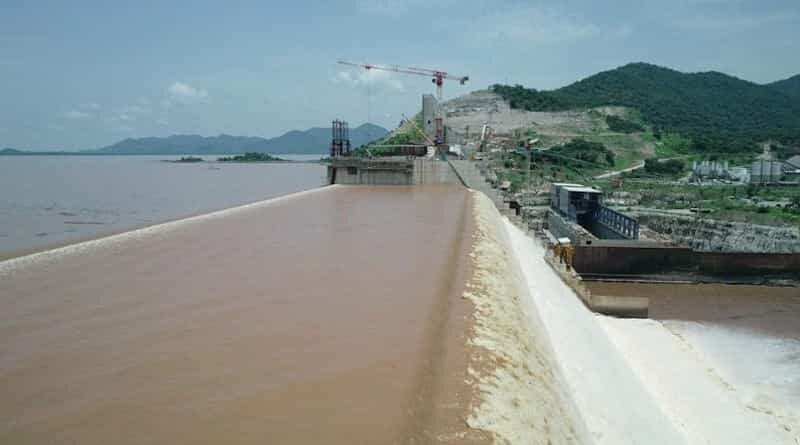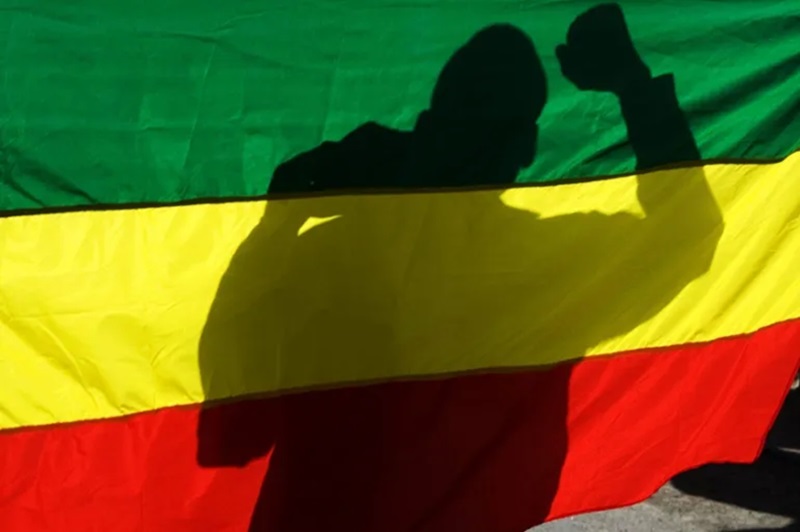[Published with permission from the Defense & Foreign Affairs Special Analysis journal]
Founded in 1972. Formerly Defense & Foreign Affairs Daily
Volume XXXIX, No. 62 Tuesday, December 21, 2021
© 2021 Global Information System/ISSA.
Analysis. By Gregory R. Copley /GIS/Defense & Foreign Affairs.

Ethiopia’s highly-volatile civil war and the associated Nile River geopolitics increasingly draw in regional and great powers in ways which may yet undermine the US/Western position in the Middle East/Horn of Africa.
It has already opened the scope for a revival of Russian and People’s Republic of China (PRC) positions dominating the Red Sea/Suez sea lane.
Ethiopia’s Government had, by the second week of December 2021, essentially turned the tide in the civil war initiated by the marxist Tigré Popular Liberation Front (TPLF). But the war is far from over, and the TPLF still has considerable firepower, funds, and foreign support available to it.
Government and civilian casualties seem likely to continue to mount as the TPLF attempts its fighting retreat through the mountain passes of the Amhara and Tigrean regions to the Tigrean capital, Mekele.
The question facing the Government in Addis Ababa, however, is how it will, in the future, regain the trust of the Tigrean people who have paid a price for the Government onslaught against the TPLF, even though the TPLF was the one which had re-started its separatist war to break Tigré from Ethiopia. Moreover, given the TPLF’s brutal suppression of non-Tigreans during its quarter century of control of the Ethiopian Government (until 2018), it is equally difficult to get non-Tigreans to trust Tigreans.
As well, the Government faces the challenge of rebuilding those parts of Ethiopia ravaged by the TPLF and its allies over the past year. This it must do without any Western momentum toward providing true reconstruction aid, bearing in mind the constant Washington mantra that the TPLF was the victim and the areas ravaged by the rebels were somehow the perpetrators.
The information dominance campaign may have left a world with little interest in rebuilding Ethiopia.
So it is clear that the Government of Prime Minister Dr Abiy Ahmed Ali will need to consider novel approaches to rebuilding the concept of a united Ethiopia in the coming years. This must, if Ethiopia is to revive its foreign direct investment (FDI) drive, include the restoration of private property, something the marxist Dergue abolished when it seized power in 1974. The subsequent TPLF and Abiy governments have not reversed that fundamental block to foreign and domestic investment.
One key difference in recent fighting is that the Ethiopian Government had finally empowered the Amhara and Afar populations to fight against the TPLF, and, while these regions had been denied the opportunities of the past to build their own regional militias to the extent of the TPLF and Oromo militias, the new support for the Amhara and Afar resistance to the TPLF has brought out thousands of self-armed farmers, some with AK-47s, many more with older mid-20th Century rifles released from Government warehouses, and some equipped only with farm implements. They have surged against the TPLF troops.
The Ethiopian Government, too, has finally achieved some real capabilities to use the unmanned combat aerial vehicles (UCAVs), acquired from Turkey, the PRC, Iran, and the UAE, to strike TPLF mechanized and armored units.
The TPLF had developed a network of relationships with other, often incompatible, Ethiopian marxist groups, particularly the Oromo Liberation Front (OLF), which is equally as genocidal as the TPLF. Some of these groups may now abandon the TPLF.
It seems unlikely, given the equation of forces and resources on each side, that the tide will turn again in favor of the TPLF, but the foreign supporters of the extremist marxist group, including the US State Dept. and the Egyptian Government, have not yet surrendered.
One significant turning point in the broader information war was that one UK publication, The Economist, broke with the tightly-controlled media consensus with an article, dispatched from the war front at Gashena, in Amhara Region, on December 16, 2021, and published in The Economist on December 18, 2021. The article described some of the realities of the fluid battlefield in a way which gave license to the rest of the media to discuss the war in more realistic terms, not governed by the TPLF’s expensive global information campaign.
It is possible, however, that a pause could be seen in the Government’s drive to eliminate the TPLF in its entirety once TPLF forces have been driven finally out of the Amhara and Afar regions. The present thrust of the Federal and Amhara forces against the TPLF was given great impetus by the natural Amhara desire to expel the oppressive neighbors. Amhara enthusiasm may not run to following the TPLF across the border into the Tigrean region.
By December 18, 2021, Ethiopian forces had fully cleared the TPLF from the North Wollo zone of Amhara Region, recapturing its strategic capital, Weldia. And by then, Sanqa, Sirinqa, Haran, Gobyen, Robit, Qobo towns, as well as Hamusit, Estayish, Ahun Tegegne, Dilb, Kul Mesk, and surrounding areas had been fully cleared of TPLF. But the next phases of fighting would likely be the most difficult. Government air power will be key, but difficult to prosecute, except perhaps for tactical use of UCAVs.
All of these areas in the Amhara Region were scenes of intense fighting during the 1935-41 war against the invading Italians by Emperor Haile Selassie I and then, after he left to whip up international support, by the Arbegnoch, the scattered groups of Patriot resistance fighters.
Meanwhile, there are reasons why Egypt continues to attempt to break up Ethiopia, something Cairo has attempted periodically over a couple of centuries. But for the US State Dept., the time may have come for it to abandon its onetime client, the TPLF. The net result for the US, however, is that it turned its back on the pro-Washington Ethiopian Government, forcing it to rebuild relations with Moscow, Beijing, Tehran, and Ankara, essentially surrendering US influence in the lower Red Sea region.
The new US Joe Biden Administration policy, led by US Secretary of State Antony Blinken, took a huge risk for no apparent reason to back the TPLF and to attempt to isolate and topple the Ethiopian Government of Prime Minister Abiy. This would have guaranteed the break-up of Ethiopia, and presumably have strengthened Egyptian control over the Suez Canal/Red Sea trade links.
Meanwhile, the ongoing and difficult rout of the TPLF has finally revealed to independent journalists — now able to get to the battlefront — the now-silent killing fields to show the massive extent of the TPLF atrocities committed against civilians in the Amhara and Afar regions.
The scale of the TPLF atrocities — at first blamed by the TPLF’s international information warfare campaign on the Ethiopian Government itself — is now being exposed, and with that the opportunity is waning for the US State Department to continue its support for the TPLF. Can, however, Sec. Blinken step back from his patronage of the TPLF, given the strong relationship which his team has had with the TPLF since the marxist group actually controlled the Ethiopian Government (1991-2018)? The approach taken by the Blinken team mirrors its approaches during two earlier Democratic Party administrations under Presidents Bill Clinton and Barack Obama. So there is the possibility that Sec. Blinken could double down on his support for the break-up of Ethiopia, with the result that the US may find itself isolated for decades from influence in the region.
The fact that the United Arab Emirates (UAE) was assisting Ethiopia militarily while at the same time rebuffing the Biden Administration on plans to sell the Lockheed Martin F-35A Lightning II fighter to the UAE was telling. Moreover, the Government of Israel was also now working to help shore up the Ethiopian Government’s position despite diplomatic pressures which Sec. Blinken had put on allies, including Israel, Italy, France, and the UK to isolate the Abiy Government.
The US even supported attempts to move the African Union (AU) headquarters from Addis Ababa to Cairo, but that was comprehensively opposed by most African states, as much out of concern about Egypt’s power as in support of Ethiopia.
Significantly, on Friday, December 17, 2021, US attempts to force a United Nations “human rights” probe into the Ethiopian civil war were resoundingly rejected by all African states, plus Russia, the PRC, and India. All supported the Abiy Government’s contention that this was an internal issue.
Meanwhile, a string of significant public protests in Europe, the Americas, and Australia brought members of the Ethiopian diaspora onto the streets to demand that the US “leave Ethiopia alone”. In the past, such demonstrations would have benefited from a strong network of ultra-left groups in their host countries, but in this recent set of demonstrations the organizers were Ethiopian nationalists.

















